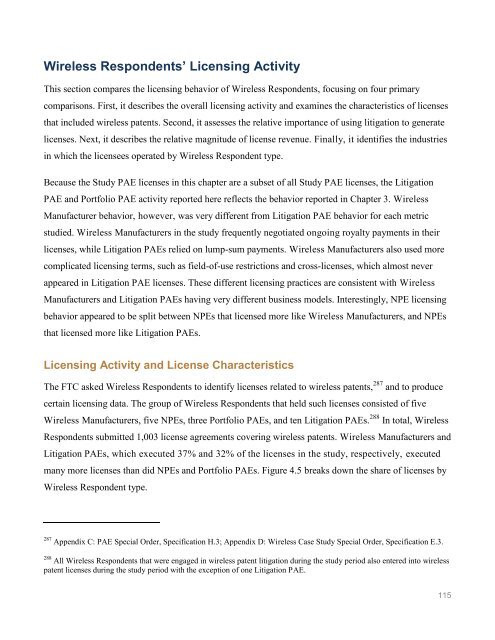Create successful ePaper yourself
Turn your PDF publications into a flip-book with our unique Google optimized e-Paper software.
Wireless Respondents’ Licensing <strong>Activity</strong><br />
This section compares the licensing behavior of Wireless Respondents, focusing on four primary<br />
comparisons. First, it describes the overall licensing activity and examines the characteristics of licenses<br />
that included wireless patents. Second, it assesses the relative importance of using litigation to generate<br />
licenses. Next, it describes the relative magnitude of license revenue. Finally, it identifies the industries<br />
in which the licensees operated by Wireless Respondent type.<br />
Because the Study PAE licenses in this chapter are a subset of all Study PAE licenses, the Litigation<br />
PAE and Portfolio PAE activity reported here reflects the behavior reported in Chapter 3. Wireless<br />
Manufacturer behavior, however, was very different from Litigation PAE behavior for each metric<br />
studied. Wireless Manufacturers in the study frequently negotiated ongoing royalty payments in their<br />
licenses, while Litigation PAEs relied on lump-sum payments. Wireless Manufacturers also used more<br />
complicated licensing terms, such as field-of-use restrictions and cross-licenses, which almost never<br />
appeared in Litigation PAE licenses. These different licensing practices are consistent with Wireless<br />
Manufacturers and Litigation PAEs having very different business models. Interestingly, NPE licensing<br />
behavior appeared to be split between NPEs that licensed more like Wireless Manufacturers, and NPEs<br />
that licensed more like Litigation PAEs.<br />
Licensing <strong>Activity</strong> and License Characteristics<br />
The FTC asked Wireless Respondents to identify licenses related to wireless patents, 287 and to produce<br />
certain licensing data. The group of Wireless Respondents that held such licenses consisted of five<br />
Wireless Manufacturers, five NPEs, three Portfolio PAEs, and ten Litigation PAEs. 288 In total, Wireless<br />
Respondents submitted 1,003 license agreements covering wireless patents. Wireless Manufacturers and<br />
Litigation PAEs, which executed 37% and 32% of the licenses in the study, respectively, executed<br />
many more licenses than did NPEs and Portfolio PAEs. Figure 4.5 breaks down the share of licenses by<br />
Wireless Respondent type.<br />
287<br />
Appendix C: PAE Special Order, Specification H.3; Appendix D: Wireless Case Study Special Order, Specification E.3.<br />
288<br />
All Wireless Respondents that were engaged in wireless patent litigation during the study period also entered into wireless<br />
patent licenses during the study period with the exception of one Litigation PAE.<br />
115


